A Retainer Agreement is a legal document or an engagement letter that acts as a contract between a client and a professional (such as an attorney or company) offering ongoing service that requires pre-payment before the work begins.
This document contains the terms of the agreement related to the compensation, the hours, contingencies, different obligations and responsibilities for both parties, expected results, the ethical work principles, the retainer fees, communication channel, and professional ground rules.
Based on this contract, the retainer paid is used as a non-refundable deposit for the services that the client has requested. The agreement is legally binding and can only be terminated or canceled with proper notice. The contract must have a retainer clause that highlights the terms of the pre-payment.
It ensures that the professional receives regular and stable payment in advance for all the ongoing and future services they will offer the client.
A monthly retainer is a repeated fee paid by a client every month to access certain services. It is also known as “pay for access.” Clients who usually use the monthly retainer need frequent and continuous services from professionals like accountants and attorneys.
These agreements are beneficial to both the clients looking for services and the professionals offering these services. That is why it is crucial to prepare a proper agreement for the benefit of both parties.
Use a Retainer Agreement Template

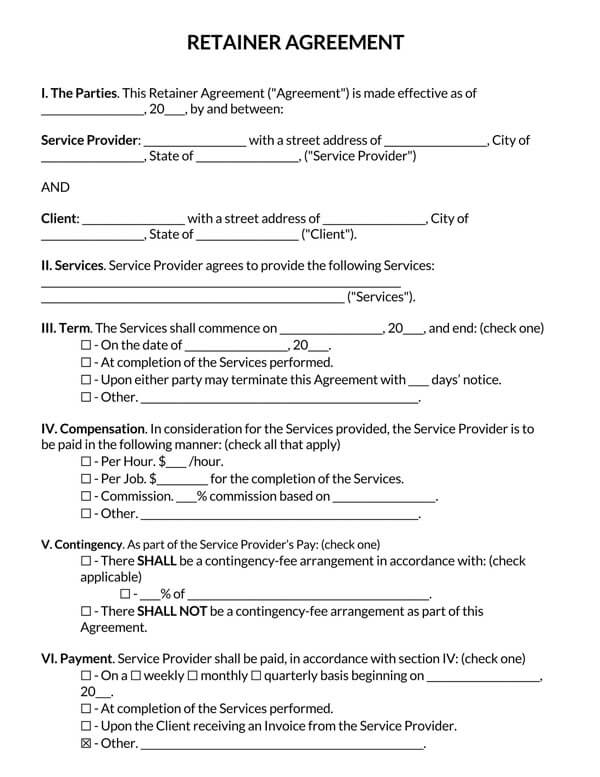
Types of Retainer Agreements
Professionals who offer consultancy services can choose from these two types of retainers while providing the requested services. It all depends on the relationship between parties, the professional’s expertise, and the period of time the professional and client have worked together.
The two types of retainers a professional can choose for billing the client are as follows:
Pay for work
Consultancy companies use the “pay for work” retainer contract to expect a continuous monthly payment from their clients for their services. This is mainly used by consultants who are just starting to build a working relationship with their clients.
These professionals are entitled to pay for all their work hours based on the “pay for work” agreement. This is different from a basic project in that the professionals must offer ongoing services to the clients in a loop.
Pay for access
The “pay for access” retainer contact is preferred by advanced consultancy firms that have built a good relationship and trust with their clients. The agreement is meant to facilitate payment based on how these professionals avail their expertise and knowledge in a particular field to their clients.
It is different from “pay for work” as it does not focus on the number of hours but instead on the level of expertise, which attracts the client to maintain them. In addition, clients pay for accessibility which is different from “pay for work.” A professional who offers such exceptional services uses this type of retainer for billing their clients.
note
Whether a professional is using the “pay for work” or “pay for access” agreement, the best method is to negotiate with a client and ensure that both parties stick to what was negotiated and agreed upon.
Retainer Agreement Templates
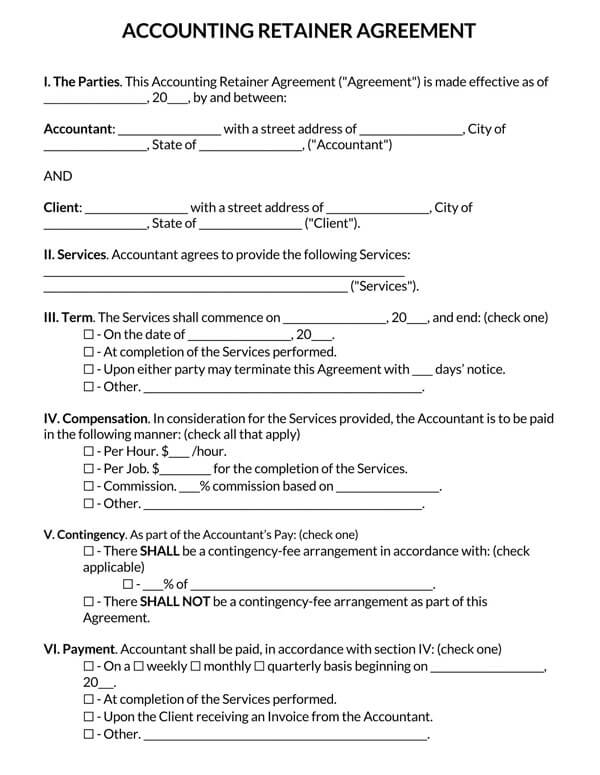
Accounting Retainer Agreement Sample
Download: Microsoft Word (.docx)
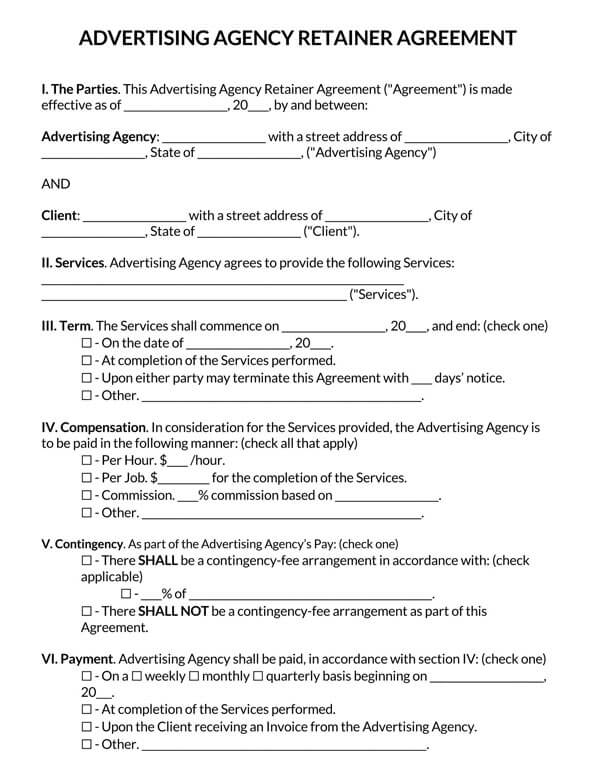
Advertising Agency Retainer Agreement Sample
Download: Microsoft Word (.docx)
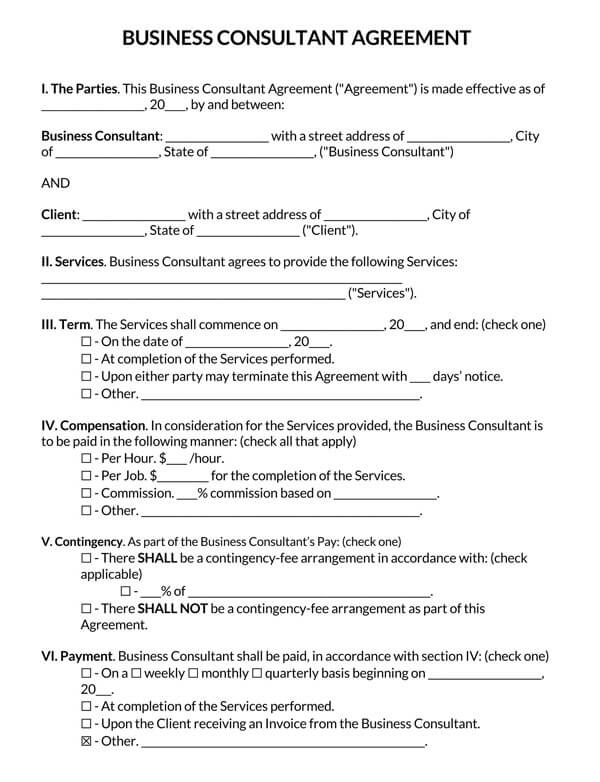
Business Consultant Agreement Sample
Download: Microsoft Word (.docx)
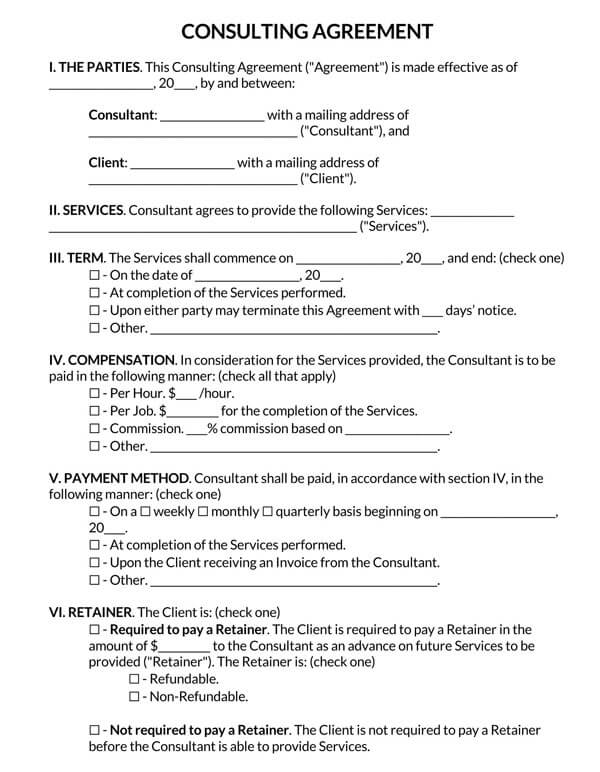
Consulting Agreement Sample
Download: Microsoft Word (.docx)
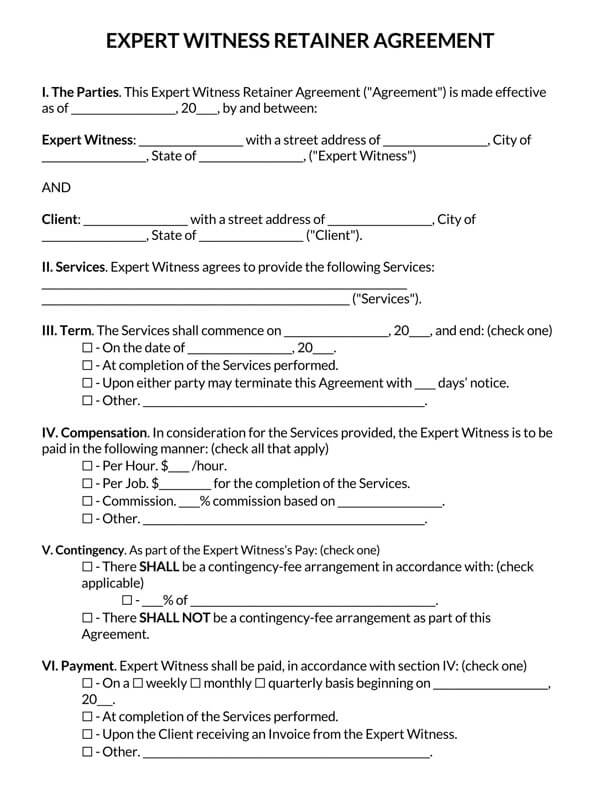
Expert Witness Retainer Agreement Sample
Download: Microsoft Word (.docx)
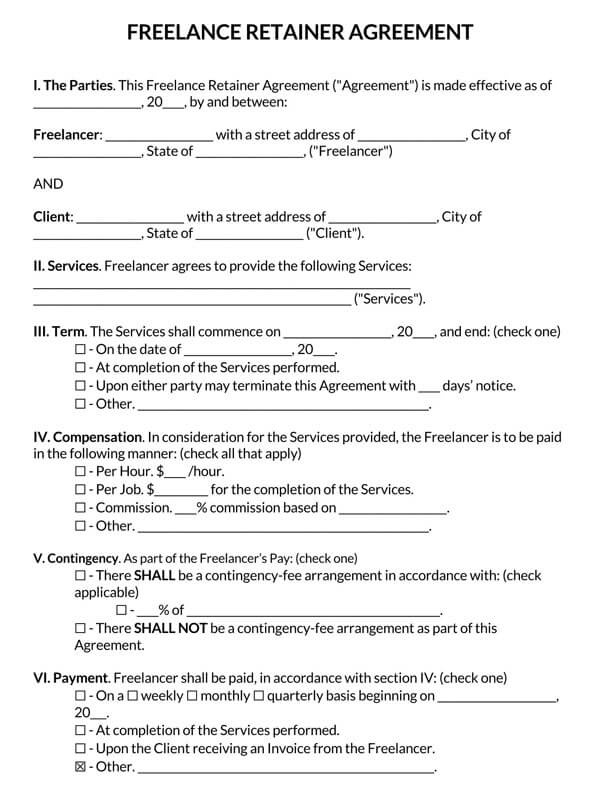
Freelance Retainer Agreement Sample
Download: Microsoft Word (.docx)
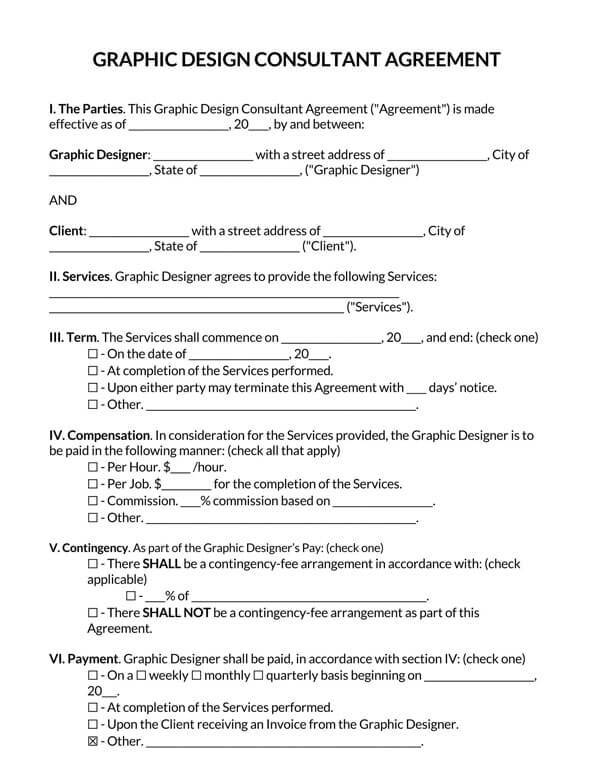
Graphic Design Consultant Agreement Sample
Download: Microsoft Word (.docx)
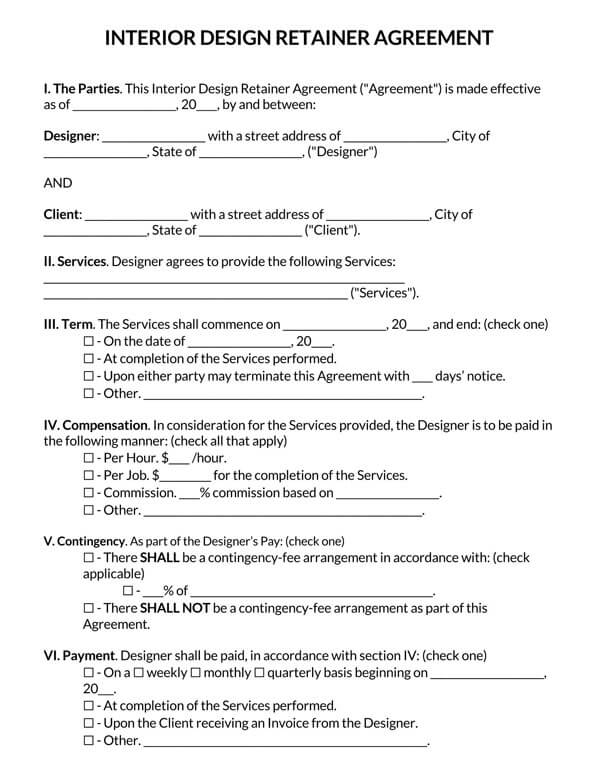
Interior Design Retainer Agreement Sample
Download: Microsoft Word (.docx)
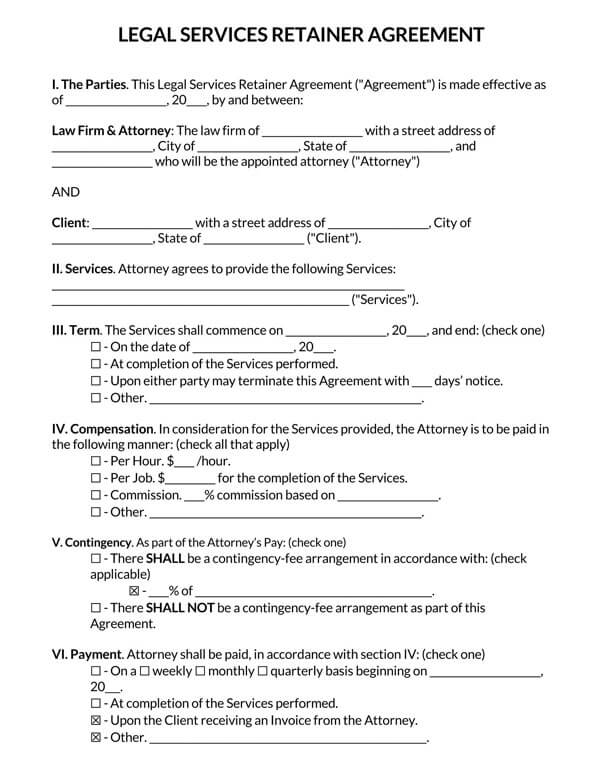
Legal Services Retainer Agreement Sample
Download: Microsoft Word (.docx)
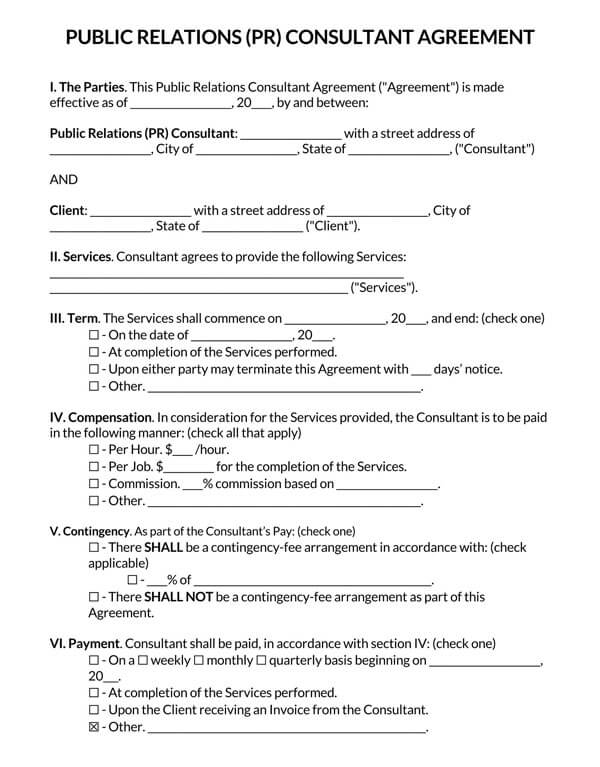
Public Relations Consultant Agreement Sample
Download: Microsoft Word (.docx)
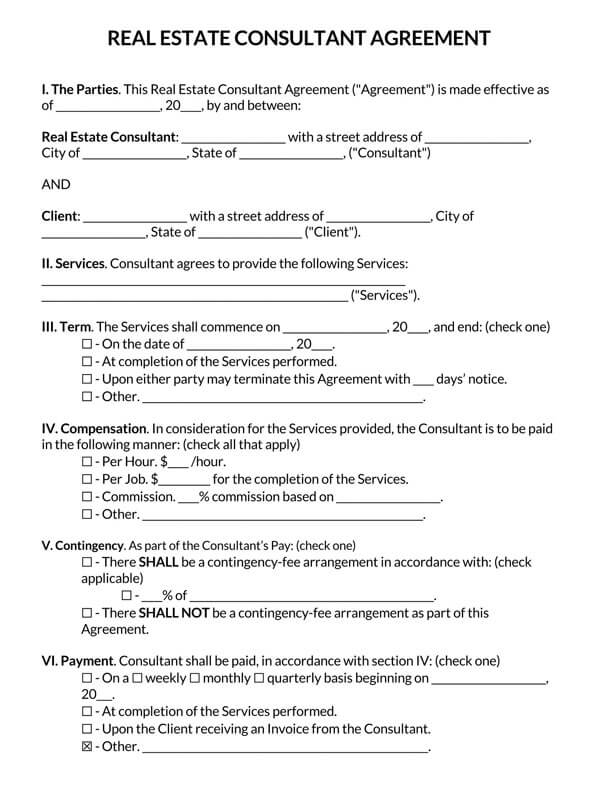
Real Estate Consultant Agreement Sample
Download: Microsoft Word (.docx)
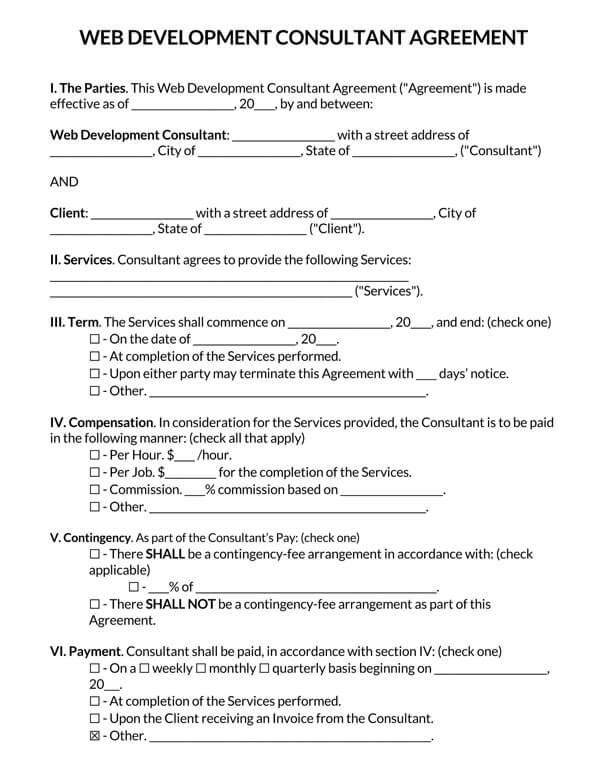
Web Development Consultant Agreement Sample
Download: Microsoft Word (.docx)
Advantages and Disadvantages
Most consulting firms have started using it since these contracts offer long-term work for stable and regular income. Clients looking for such services also prefer using it in their business deals. Here are some of the benefits and disadvantages that such professionals and clients will experience for using this agreement instead of one-time or fixed-price contracts or projects.
Benefits/advantages of a retainer agreement
Following are some benefits/advantages of it:
Constant legal advice
With it, a client can access constant legal services until their case is concluded in court. Then, they can choose the best representation for their case and pay for access to these services for as long as they want.
Stable income
For a scenario where a client needs access to a particular set of skills or expertise, professionals get benefit from using it as they are guaranteed stable income for as long as the client needs them.
Better budgeting
Clients can make a budget well if they use this agreement compared to dealing with one-time projects. The contract allows them to access quality services while being aware of the expected monthly fees; hence, they can budget and plan for short and long-term expenses.
Build trust and improve relationships
Professionals can build trust and improve relationships with their clients.
EXAMPLE
Consultancy firms billing their clients using the retainer agreement tend to interact with them and solidify their working relationship frequently.
Generate profits
Both professionals and clients can generate profits by using this agreement. Professionals can focus on a client and produce the best work, which is profitable when their clients refer them to other clients. Clients can avoid the hassle of looking for a consultancy firm and save time achieving their goals since the services they need are already being provided. Professionals will be able to reduce the time they spend selling their services, while clients will predict the flow of cash.
Disadvantages of a retainer agreement
Following are some disadvantages of a retainer contract:
Pre-payment is a risk
Clients risk paying for services that they will not use. Since it is all about pre-payment for future services, clients might be at risk of dealing with losses by paying for services they might never need. This usually happens when clients seek legal advice, and their case does not require any recurrent representation.
It can be really expensive
Another disadvantage is that the advance to be paid by the clients to the professionals before work begins may be arguably expensive. That means, it is better for the client to agree on the one-time flat fee or the service-based retainer as compared to paying on a regular basis based on the hours the professional has worked
How Retainer Agreement Works
For it to be set up, a client must first seek the type of services they are looking for in exchange for money from a professional. The agreement will then be set up to guarantee pre-payment before the professional begins offering their services.
Here is how this agreement works:
Negotiate the compensation
The professional offering their services and the clients will meet to discuss the scope of the work. They will also discuss the type of fees to be paid, the expected retainer amount, and the agreement’s termination.
The service provider can use the following ways to negotiate with the client and come up with an effective agreement that is beneficial to both parties:
Prove your value
As a service provider, the only way to get a proper retainer is by proving to the clients that you are valuable. Displaying your expertise is the best way to prove your value, and this can be done by displaying a good relationship with the clients. Having a good reputation is another way of putting forth your strength so that the negotiation with the client will be successful.
Offer a retainer discount
Another way to negotiate with a client is by offering them a discount. This is best if the service provider is not in high demand and the client is worried about the pre-payment. A good discount will encourage the client to agree and provide a stable income for the professional.
note
A renowned service provider should avoid giving discounts to their clients, and if they do, they should not refer to it as a discount but as a unique package. This way, the client will still agree on the retainer agreement but will not view the service offered as less valuable.
Pitch your retainer services
The professional should also try and pitch their services and the importance of the agreement. They should be transparent as possible to convince the clients about the kind of services they are offering and how the client will benefit from their availability. However, the service provider should only pitch services they can provide and make promises they can fulfill.
Aim for a time-bound retainer
The last and effective way to negotiate with the client is by setting up goals that last for a while. This agreement works best if the work period lasts for several months. However, suppose the client is still adamant about the agreement. In that case, the service provider can offer a trial period and break down the services they will offer the client when they are working together based on the agreement.
Choose the type of retainers
There are two types of retainers, that is, pay for work and pay for access. After the negotiations have happened and the parties have an agreement, the service provider should choose the specific type used to make the negotiations official.
Sign the retainer agreement
Both parties can now write down all the terms of the agreement and fill in the contract thoroughly. The next step is for both the service provider and the client to sign the agreement.
Get paid
After signing it, the client should pay the professional before they can start working. Usually, it contains the clause that reads, “no work may begin until the retainer has been paid, in full, by the client.”
This means that the professional must get paid the agreed-upon retainer before they can offer their services.
Essential Parts of a Retainer Agreement
Although these agreements may vary based on the type, style, and length, essential parts must be included in it.
Regardless of the jurisdiction or case, these three parts are expected in the agreement:
Scope/nature of work
The scope or nature of the work involves the responsibilities and services expected from a professional like an attorney. This will include all the tasks that they are expected to do for the client.
For instance, a corporation might require a lawyer to draft contracts, which is different from an individual client who might need a lawyer to win a particular case.
It protects the professional from delivering services that they had not agreed to if asked by the client. In case of any change, the agreement will ensure that both parties can appropriately set work boundaries; hence avoiding requests that were not mentioned in the earlier negotiations.
With specific services, the professional can get paid for the additional work received from their client. This way, both parties will prevent confusion and mishaps as they work together.
Retainer fee
Based on the scope or nature of the work, the retainer fee is another important part that should be included in a retainer agreement with specific examples of what is being paid for. The retainer is the amount that should be paid in advance by the client.
The law requires a professional to include a reasonable amount of fees for their services bound by ethics and based on particular factors.
The fees can be set based on the following factors:
- Time and effort spent investigating and representing the case
- The amount paid for similar cases with the same complexity in that particular location
- The time limitations that the legal team is facing
- The level of expertise, reputation, and competence expected from the lawyers
- The costs for coordination and logistics.
- Professional relationship’s nature and the length of it
There are three types of retainer fees that a professional may charge their clients, and they include:
Contingency fee
This is a compensation amount paid by the client to the professional, especially a lawyer, after personal injury cases such as negligence and accident cases. It is usually a percentage of the client wins from such cases after deductions have been made.
It may range from 25 percent to 40 percent, with 33 percent being the best place to start. The contingency fee is preferred for legal and consulting services. This is because clients will only make the payment if the services meet the contingency required.
note
The modified contingency fee is a variation that includes a reduced percentage and reduced hourly rate.
Hourly fee
This fee is more effective and beneficial to the professional than the value they might be offering the clients. The client is supposed to pay the fee for every hour of service offered.
This type of fee is usually preferred based on the subject at hand, the expertise of the professional (attorney), and the case’s complexity. The hourly fee is preferred if the attorney is likely to face any risk or liability related to the case.
Flat fee
This is preferred by attorneys dealing with criminal cases, incorporations, and will drafting in a retainer agreement.
Client expenses
The other important part is the client’s expenses. The client is responsible for some of the expenses like travel costs of the professional and filing expenses. It must highlight which expenses should be paid by the client, regardless of how the case turns out.
Basic Contents of a Retainer Agreement Template
A template contains this content and blank spaces next to the content that must be filled before both parties sign the retainer agreement. This information is essential as it directs how the contract will unfold.
The name of the retailer, service provider, and client
Section I
After downloading the template, the first required contents include information about the parties, the service provider, and the retainer. For example, section one requires details of the date when the agreement will become effective, followed by a label indicated as “parties” which shows the service provider’s name and address, and the client’s name and address.
Section II
Section two with the title “services” will require descriptive information about the services offered by the professional to the client. These details will help to establish the kind of relationship that the parties have.
The starting and ending dates of the service
Section III
Section three, titled “term,” will require you to fill in the start and end date of the services. A series of checkboxes are available in this section to mark the statements that relate to the agreement at hand.
The first two blank spaces require date information of when the professionals will begin their work. After that, the appropriate checkbox will be filled in. There are four checkboxes with different information regarding when the working relationship will end.
The end date might be:
- An agreed-upon calendar date,
- After the services being offered have been completed,
- If either party chooses to terminate the agreement with a few days’ notice (the number of days must be indicated) or
- Other details that might lead to the end of the agreement.
The pay rate/manner of compensation
Section IV
The following section four is entitled “compensation.” Here the information will be filled almost as similar as the above section. The difference is that even after marking the suitable checkbox, additional information will be required. Also, multiple checkboxes can be marked based on the agreement between the two parties instead of marking only one checkbox.
The manner of compensation includes per hour, per job, and commission alongside the amount of money to be paid. Finally, the fourth option requires a description of the pay rate if the three checkboxes do not explain the professional pay rate.
The payment and retainer
Section V
“Contingency” is the title of the next part in the template. This section requires details about any other additional payments that the client and service provider discussed. There are checkboxes in this section too. If there will be a contingency fee paid to the professional, the appropriate checkbox should be marked.
The same is true if there is a contingency fee to be paid to the service provider; the percentage and the funds used for this purpose must also be indicated.
Section VI
Section six, titled “payment,” will require information on the payment amount and how regular the client will make this payment to the service provider. In addition, several checkboxes should be marked based on the decision made between the client and the professional.
The payment frequency may be weekly, monthly, or quarterly based on the beginning date of the agreement. The terms for the payment to be made may include after the completion of services when the client receives an invoice or a final checkbox that requires a description of the payment manner.
Section VII
The retainer to be expected by the professional should also be included in the contract, and this information is input in section seven titled “retainer.” Checkboxes are also present in this section and should be filled appropriately. For example, if a retainer is required, the appropriate checkbox should be ticked, and the amount to be paid should also be indicated.
The agreement should have information concerning whether the retainer is refundable or not. If no retainer is required, then the appropriate checkbox should be marked.
Required expenses for the project
Section VIII
The next section is of the “expenses”. Checkboxes will also be used in this section to indicate all the required expenses for the project and who is responsible for paying those expenses. The first checkbox is marked as if the service provider will be responsible for all the expenses. The second is marked if the client is expected to reimburse or pay back the professional for some expenses.
These expenses should be mentioned clearly. The third one is marked if the client is planning on taking responsibility for all the expenses for the project.
Necessary information to handle disputes
Section IX (Disputes)
Information regarding handling disputes in case they occur between the two parties is also essential and must be included. The information about the arbitration required to resolve the disputes will include the location of the process. The terms of the arbitration will also be included in the agreement.
Section X (Legal notice)
For this section, information about the mailing address of both parties is required. This is useful in case of disputes, and either party needs to communicate with the other party about an obstacle or any misinterpretation of the agreement. The client and service provider’s mailing address should be indicated here as well.
The place where the agreement is governed
Section XX
This section requires information about where the contract will be subjected to governance based on federal law. Therefore, the State should be written as it will indicate the location where the terms of the agreement will be executed and even enforced if necessary.
All agreed-upon obligations
Section XXII
Any extra provisions regarding it should be added in the “additional terms and conditions” section, and they should be well highlighted. Any additional information will only be viable if they are included in the contract. The space provided in this section should be filled with the extra information of the phrase “none” if there are no additional provisions.
Signature of the professional and the client
The final part is the signature of the service provider and the client, together with their printed names and the dates when the agreement was signed. There are respective lines for each party to sign. After signing, the working relationship between the two parties can commence.
Frequently Asked Questions
It must be in writing in most jurisdictions, but no State laws require a professional and client to have the agreement. This is especially true if the services being sought have not been offered to the client in the past.
For instance, in the case of attorney and lawyer, the Rules of Professional Conduct mention that the agreement should be in writing if the lawyer has not meant to offer their services to the client before.
All clients looking for legal advice and representation from their attorneys need to have it before entering a legal relationship with them. Clients with the following cases will significantly benefit by using it:
• Divorce, custody, and family law
• Personal injury and medical negligence
• Criminal charges
• Drafting contracts
• Civil cases
• Businesses and freelance worker representation
These cases usually take a while and having ongoing legal services from an attorney will be time-saving and affordable.




